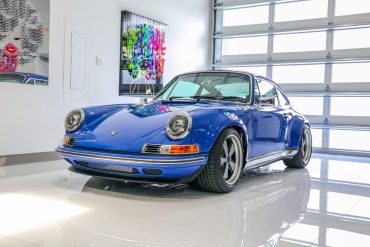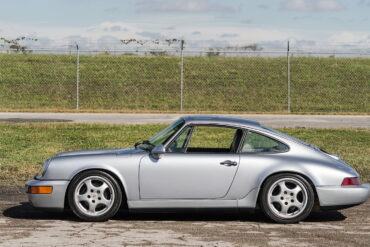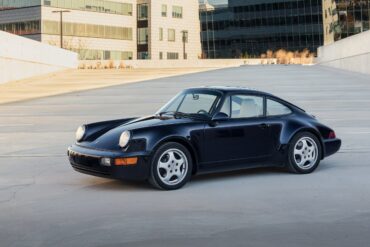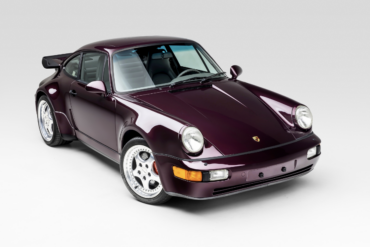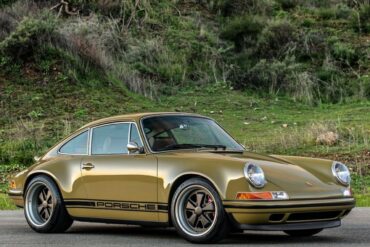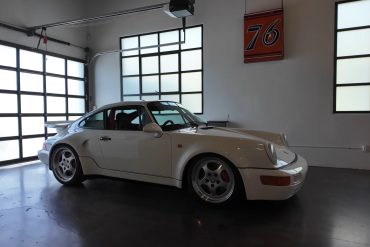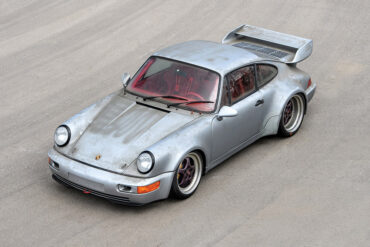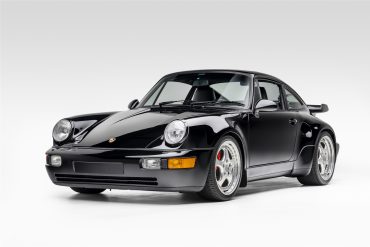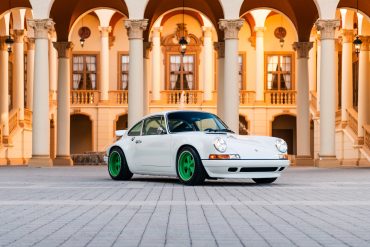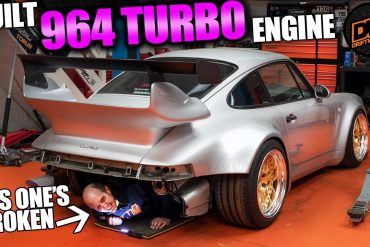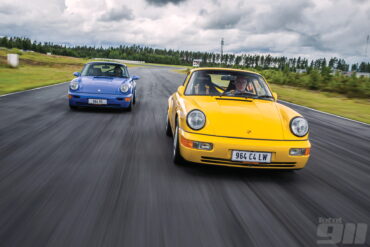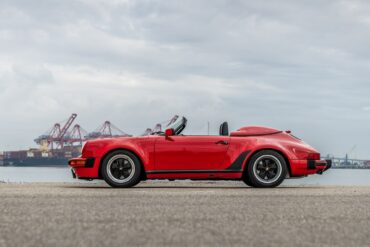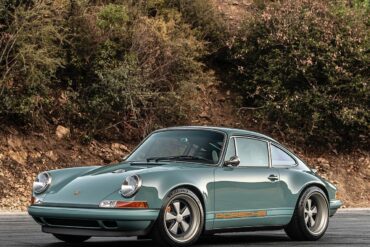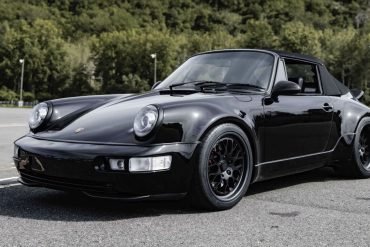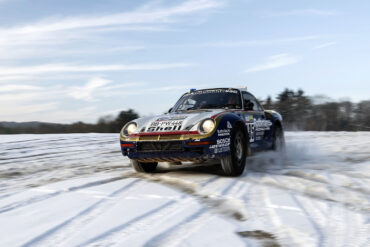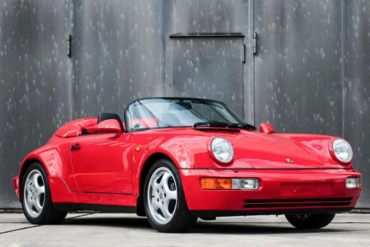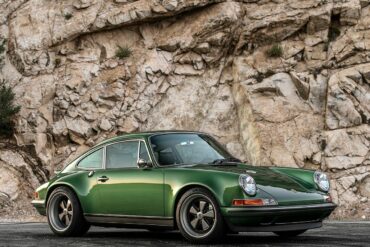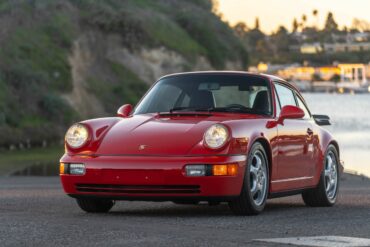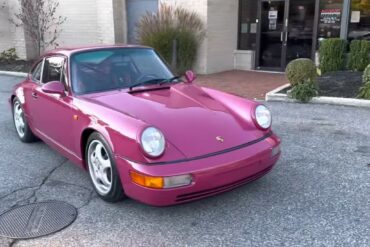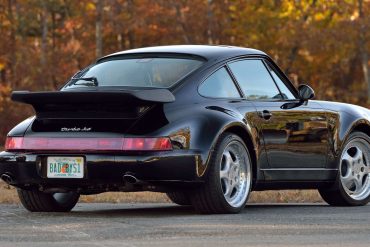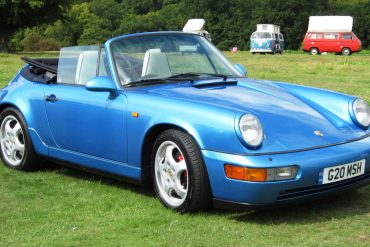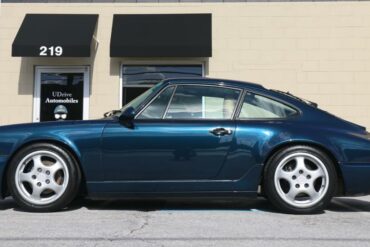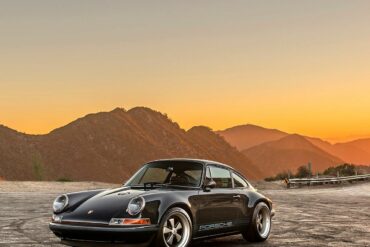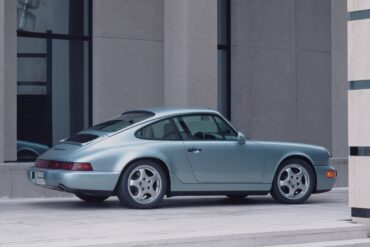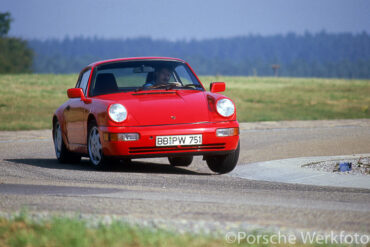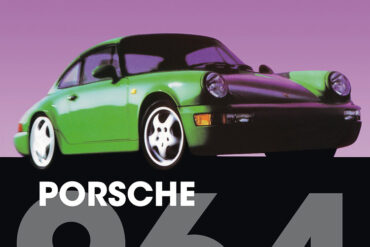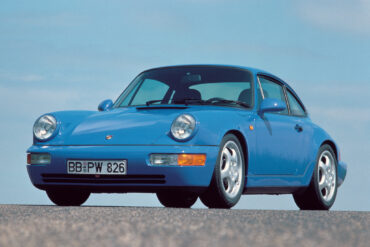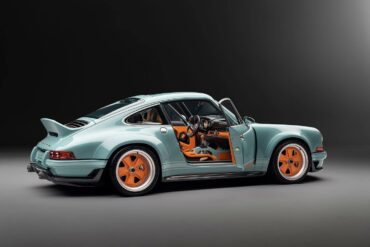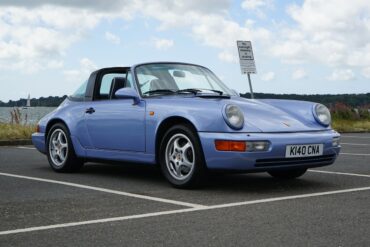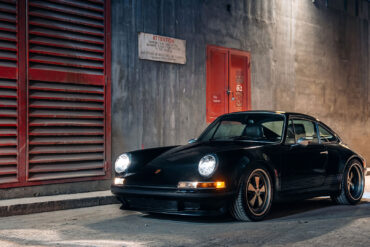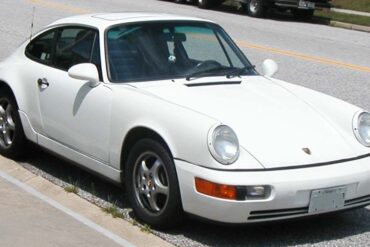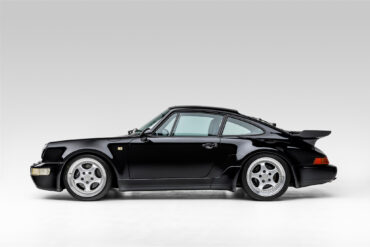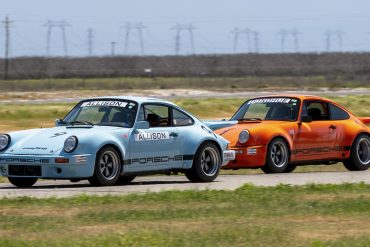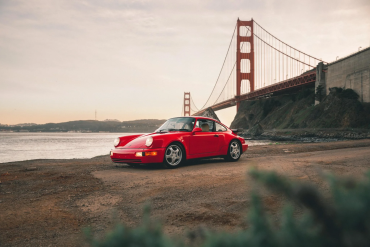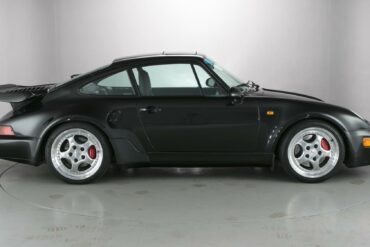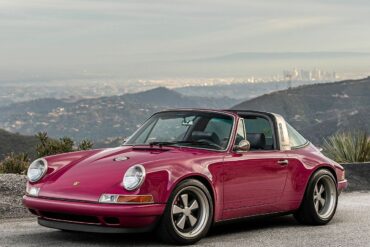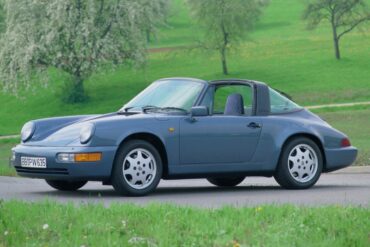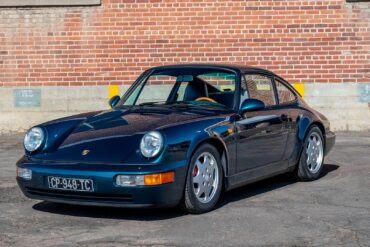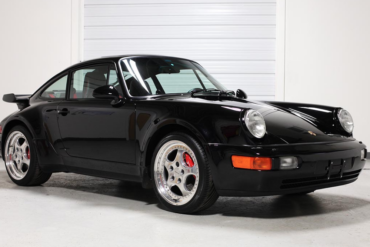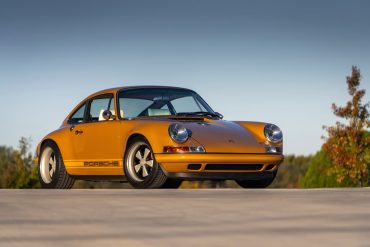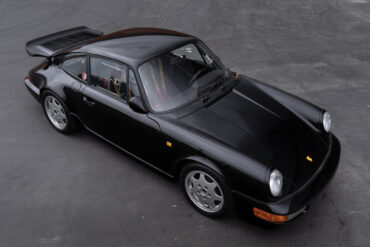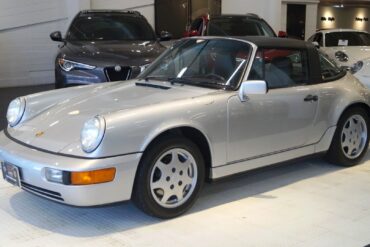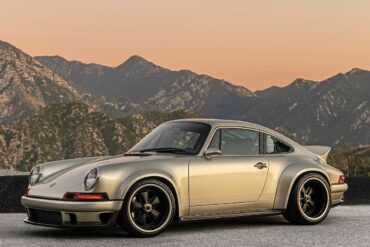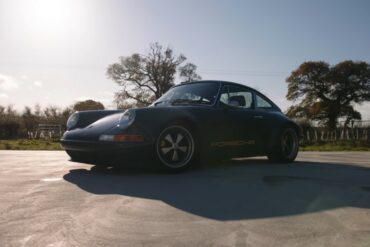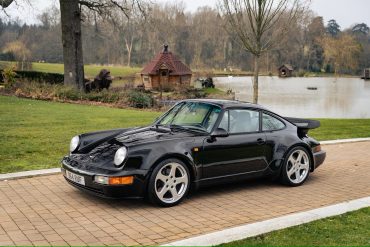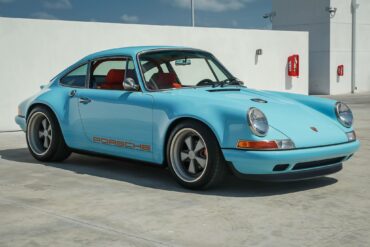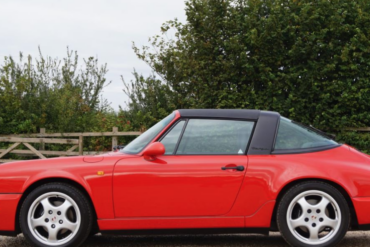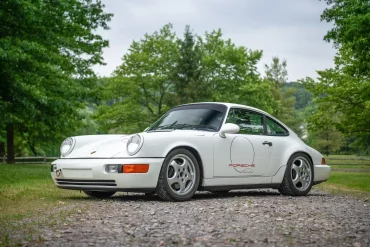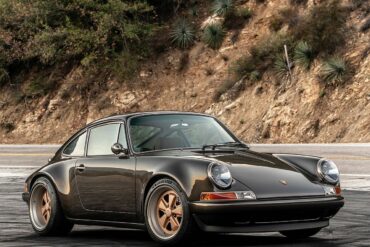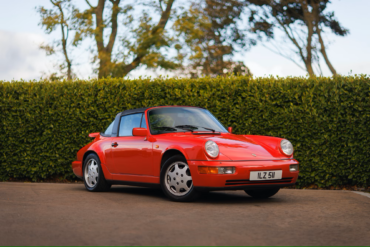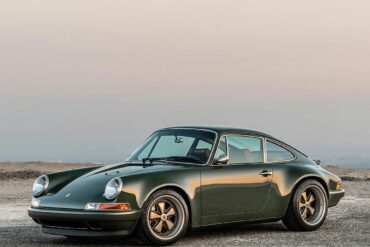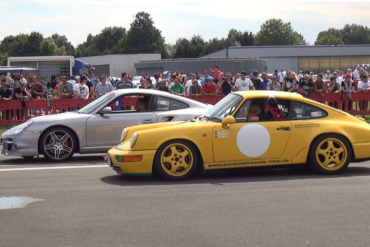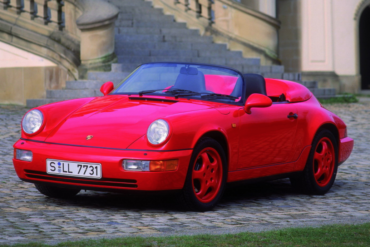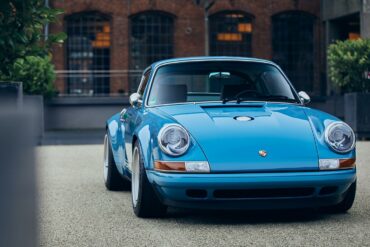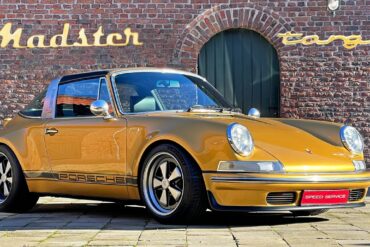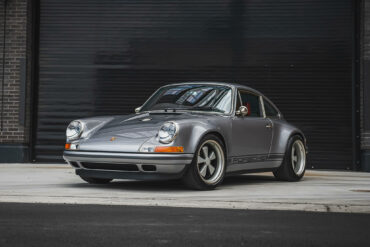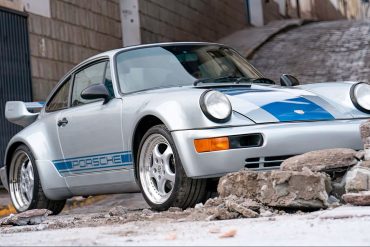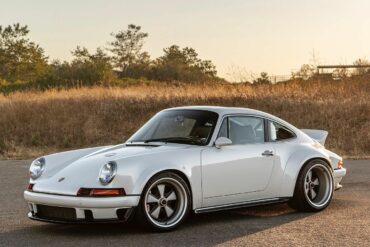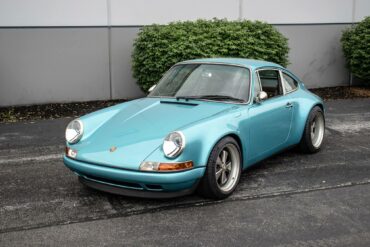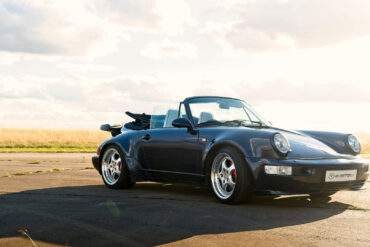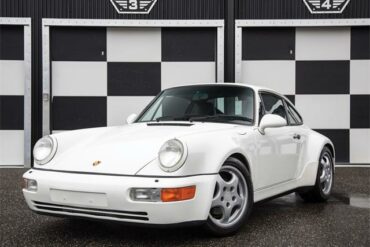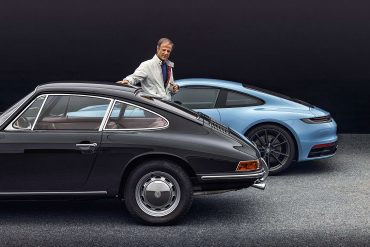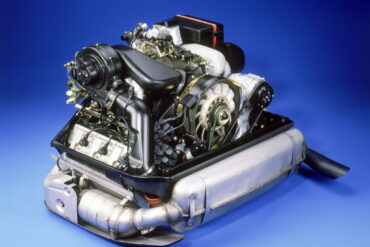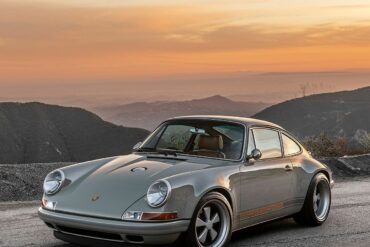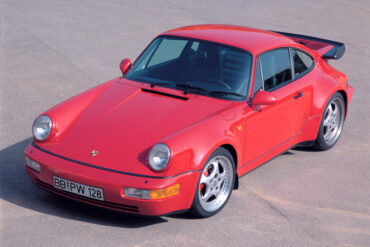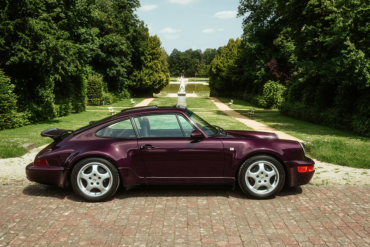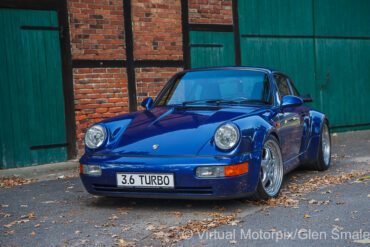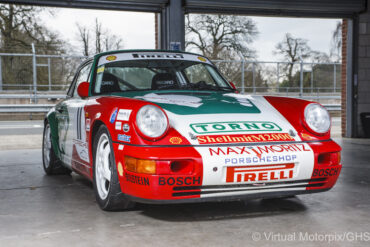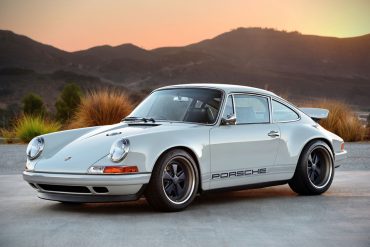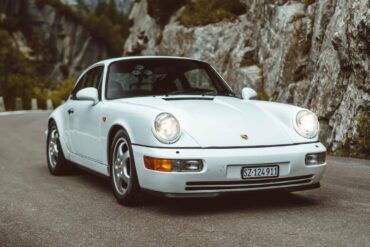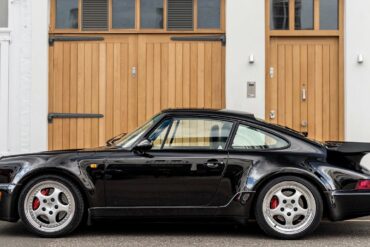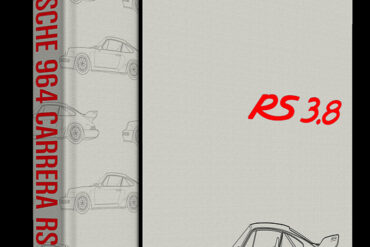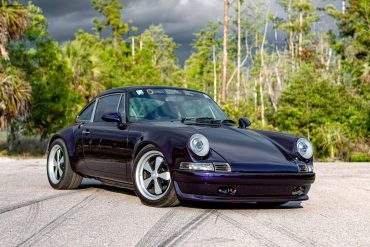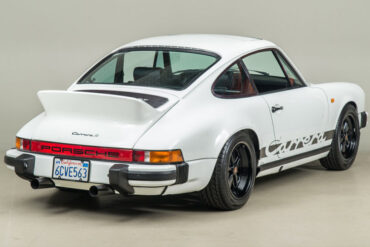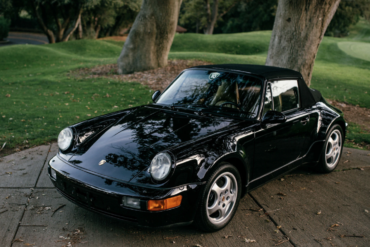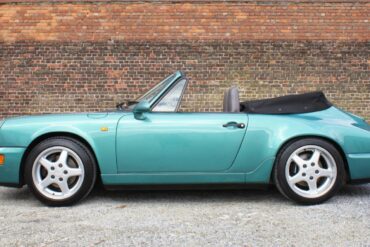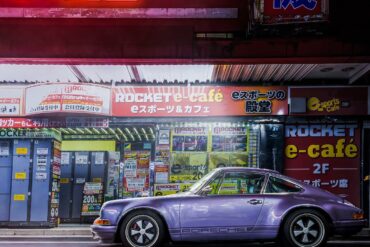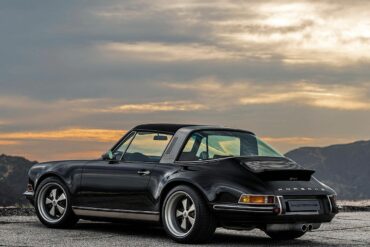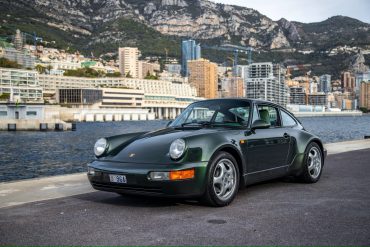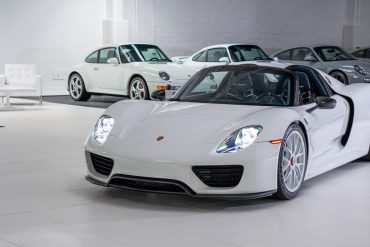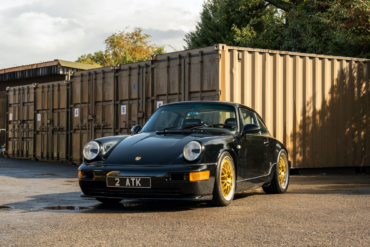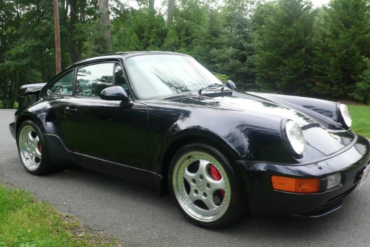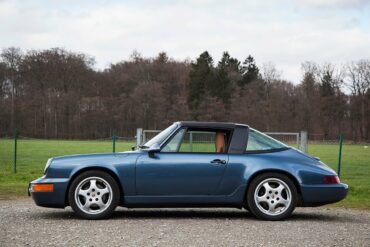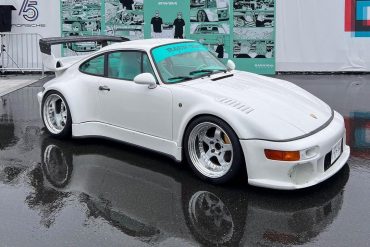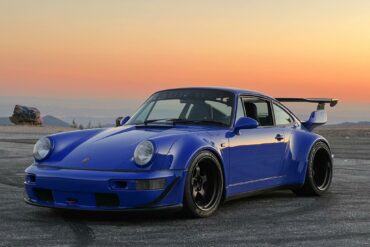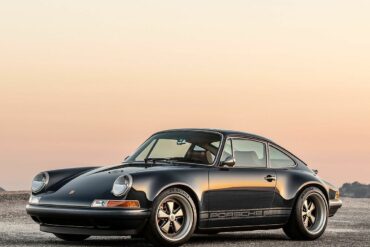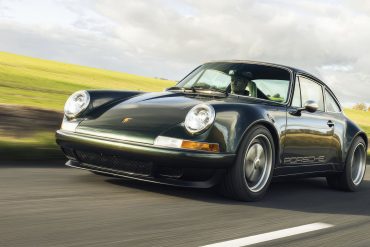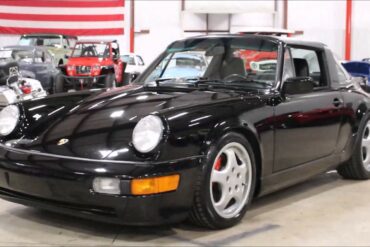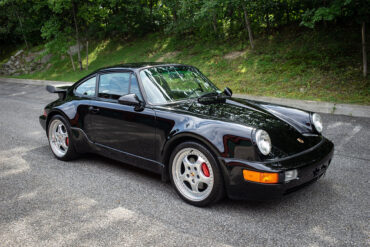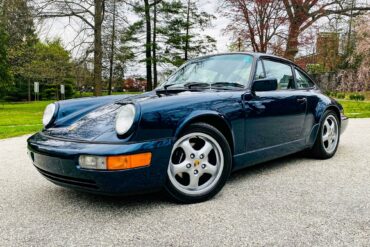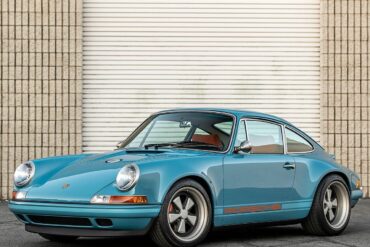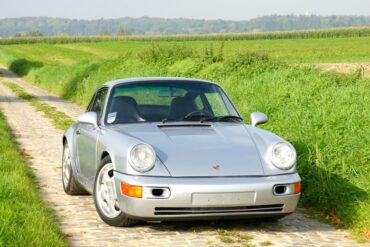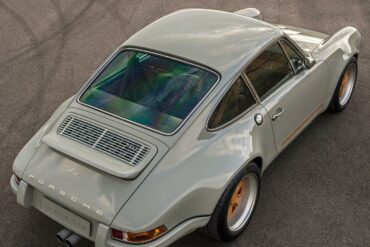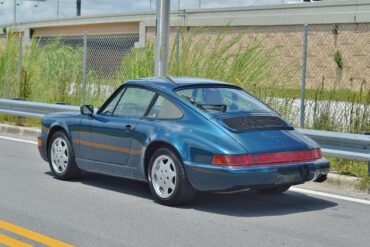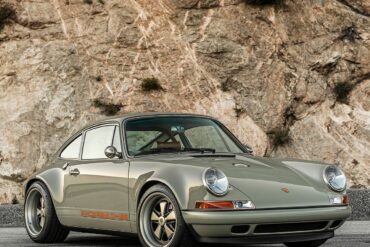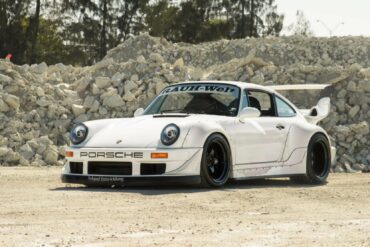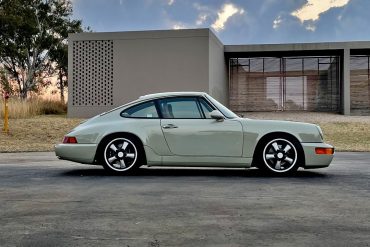Starting with a European-market 964 Carrera 4 that retains its original numbers, this 1991 model underwent an extensive custom nut-and-bolt...
Porsche 911 (964)
In 1989 Porsche came out with the 911 Carrera 4 (964). The new 911 was a contemporary take on the classic two-door sports car and came at a time when many were predicting the end of the 911 (the company was producing the 944 and working on the upcoming 968). The long run of the previous 911 meant the 964 needed a major update and Porsche delivered on that promise with 85% new components and virtually none of the predecessor’s architecture used. Save for the introduction of aerodynamic polyurethane bumpers and an automatically-extending rear spoiler which replaced the “whale tail” found on the 911 throughout the 1980’s, externally, the 964 kept the same style as the classic 911. The 964 rode on a completely redesigned chassis with rear suspension switching from torsion bar to trailing arms with Porsche’s “Weissach” rear axle, which added self-steering elements to reduce the chance of oversteer. It featured a naturally aspirated 3.6 liter boxer engine that produced an impressive 250 horsepower. See all of our Porsche 964 Research.
Porsche Option Codes – Porsche 911 (1993 Model Year) Looking to decode your 1993 Porsche 911 option codes? Want to...
1994 Porsche 911 Carrera 4 Coupe (964) Technical Specifications Engine Type Flat 6 Induction Normally-aspirated Cooling Air/oil-cooled Valvetrain Single overhead...
An Eye-Catching Amethyst Metallic 964 Porsche 911 Turbo Fetches Big Money At Auction How about $401,000 for a 1994 Porsche 911...
Singer Vehicle Design – New Zealand Commission Today, we take a closer look at the Singer Vehicle Designs New Zealand...
In Magnus Walker’s newest video on YouTube, we get a closer look at an ultra-rare 1993 Porsche 964 Turbo S...
Introducing Theon Design’s newest custom creation, ‘BEL001’: a hand-crafted, steel-bodied Porsche 911 (964) with a powerful 3.6-liter supercharged air-cooled flat-six...
With the 1993 Carrera 2 as the starting point, Porsche had to make at least 50 roadgoing cars in order to qualify this new model for the Carrera ADAC GT Cup, which served as the basis for a motor racing variant to come, the Carrera RSR 3.8. The RSR 3.8 was nothing short of an all-out race car that could be delivered to the track in a ‘just add driver’ form. The Porsche Carrera RSR 3.8 racked up a catalogue of impressive international race results right from the outset, winning overall at the Spa 24 Hours, Suzuka 1000km, and the 24 Hours of Interlagos.
In 1993, Porsche introduced the 911 Turbo 3.6, featuring an enhanced 3.6-liter single-turbo flat-six engine as a replacement for the...
Established in Los Angeles in 2009, Singer Vehicle Design is a prominent figure in reimagining Porsche 911s from the 964-generation...
Scary First Start 600hp Aircooled 964 Turbo Engine in my RWB Porsche 911...
Rare & Special Race Versions of the 964 For issue 131 of Total 911, you may remember that we made...
The 1989 model of Porsche’s 911 Speedster model lineup is arguably one of the most recognizable as the 911 Speedster...
Singer Vehicle Design – Long Island Commission Today, we take a closer look at the Singer Vehicle Designs Long Island...
While I admit the title is misleading, American company Sacrilege Motors does have the answer to the question; “Both.” That’s...
Factory recommissions the famous Porsche 959 Paris-Dakar The recommissioning has been carried out over the past few months by the...
In contrast to the 911 Speedster from the 1989 model year, the 964 Speedster was only offered and produced with the narrow body shape. In December 1991, the first wide bodied prototype based on a 964 Carrera 2 Convertible Turbo-Look was registered at Porsche AG, but it never made it ready for a series production. In response to recurring customer requests for Turbo-Look Speedsters - the optical characteristics of the wide body in combination with the flat windscreen and fiberglass cover had found many fans - Porsche converted the previously individually ordered, narrow Speedster in the exclusive department.
Singer Vehicle Design – Copenhagen Commission Today, we take a closer look at the Singer Vehicle Designs Copenhagen Commission. This...
Sackey & Co. is proud to offer a stunning example of a 1993 Porsche 911 RS America finished in factory...
Autosport Designs takes the Porsche 911/964 RS N/GT Clubsport for a test drive. One of only 290 examples produced and...
Porsches are, by nature, expensive cars. Still, it’s hard not to notice when one sells for over a million dollars,...
1990 Porsche 911 Carrera 2 Cabriolet (964) Technical Specifications Engine Type Flat 6 Induction Normally-aspirated Cooling Air/oil-cooled Valvetrain Single overhead...
Porsche Option Codes – Porsche 911 (1994 Model Year) Looking to decode your 1994 Porsche 911 option codes? Want to...
Singer Vehicle Design – Tatooine Commission Today, we take a closer look at the Singer Vehicle Designs Tatooine Commission. Like...
1990 Porsche 911 Carrera 4 Coupe (964) Technical Specifications Engine Type Flat 6 Induction Normally-aspirated Cooling Air/oil-cooled Valvetrain Single overhead...
Type 964 family line-up in 1990 showing the Carrera 4 range: (from front to back) Cabriolet, Targa and Coupé From...
Porsche 964: The Modern Classic by Paul Koebrugge – © Paul Koebrugge The history of Porsche sportscars is peppered with...
The rarest 964 RS variant was the awesome 964 C4 Lightweight. Known as the 964 Leichtbau it made use of...
Singer Vehicle Design – Milano Commission Today, we take a closer look at the Singer Vehicle Designs Milano Commission. First...
1992 Porsche 911 Carrera 4 Targa (964) Technical Specifications Engine Type Flat 6 Induction Normally-aspirated Cooling Air/oil-cooled Valvetrain Single overhead...
The latest bespoke Porsche 911 (964) commission to come out of Theon Design’s Oxfordshire workshops has been unveiled – the...
Porsche 911 (964) Technical Specifications & Model Comparison (European Variants) European specs 911 964...
The 964 Turbo was introduced in 1990 and it featured a widened bodywork compared to the standard 964. It also...
The 15th Targa California rally recently concluded with most drivers logging 1,000+ miles over the roads “less traveled” of California’s...
Bid now to get the chance to acquire one of the rarest 964s ever built, a 1992 Porsche 911 Turbo...
The Porsche factory had 93 Turbo chassis left. These were all transferred to Porsche Exclusiv and hand built as the very special 964 Turbo 3.6 S. They were offered with normal, or ‘Flachbau’ slant nose front ends. While the vast majority of Turbo S’ were fitted with the ‘Flachbau’ nose as a no-cost option, the Turbo S could also be had with the traditional 964 nose as well. In all, 76 Flatnose cars were made while 17 non-Flatnose (known as Package option) cars were made. These cars were also fitted with the X88 option, which increased power to 380 hp. 75 flatnose units were produced.
Singer Vehicle Design – Max Power Commission Today, we take a closer look at the Singer Vehicle Designs Max Power...
1993 Porsche 911 Carrera 2 Targa (964) Technical Specifications Engine Type Flat 6 Induction Normally-aspirated Cooling Air/oil-cooled Valvetrain Single overhead...
Get ready to add a unique air-cooled 911 from the early 1990s to your Porsche collection as Broad Arrow Auctions...
1991 Porsche 911 Turbo 3.3 Coupe (964) Technical Specifications Engine Type Flat 6 Induction Turbocharged Cooling Air/oil-cooled Valvetrain Single overhead...
This Saturday, Mecum Auctions will be offering a beautiful 1990 Porsche 911 Carrera 2 Coupe that has been reimagined by...
The rarest 964 RS variant was the awesome 964 C4 Lightweight. Known as the 964 Leichtbau it made use of surplus parts from 953 Paris-Dakar project. A handful of specially prepared lightweight 911s were fabricated by the Porsche factory and called the Carrera 4 RS Lightweight. Carrera RS Body with 959-like AWD wizardry and more power. Lightweight masterpiece. Used parts from 953 Paris-Dakar project. The 964 C4 Lightweight was powered by the same 3.6 liter flat six as the normal 964 RS, but was fettled to produce 300 hp.
1990 Porsche 911 Carrera 2 Targa (964) Technical Specifications Engine Type Flat 6 Induction Normally-aspirated Cooling Air/oil-cooled Valvetrain Single overhead...
Singer Vehicle Design – Caroline Commission Today, we take a closer look at the Singer Vehicle Designs Caroline Commission. First...
Alex Kersten goes behind the wheel of the 1 of 1 Theon BEL001, a restomod Porsche 911 (964) for a...
This Porsche RUF 911 RCT, from the 964 era, serves as the origin of the RUF RCT model and was...
The Puerto Rico Commission stared out as a US-market 964 Carrera 2 that has been disassembled and rebuilt with a...
1993 Porsche 911 Carrera 4 Targa (964) Technical Specifications Engine Type Flat 6 Induction Normally-aspirated Cooling Air/oil-cooled Valvetrain Single overhead...
Manufactured by Porsche Motorsport for use in their U.S. customer racing series, the Porsche 964 Carrera Cup vehicles originated from...
The “Indy Commission” by Singer Vehicle Design was built for IndyCar legend Dario Franchitti. Powering the Indy commission is a...
Collecting Cars is auctioning a stunning example of the 964-generation Porsche 911 Carrera 2 Targa. This particular example is offered...
Singer Vehicle Design – Montauk Commission Today, we take a closer look at the Singer Vehicle Designs Montauk Commission. This...
Quarter mile drag race between the air-cooled Porsche 964 RS versus a 911 Turbo from the 997-generation....
1993-1994 Porsche 911 Speedster (964) Technical Specifications Engine Type Flat 6 Induction Naturally Aspirated Cooling Air/oil-cooled Valvetrain Single overhead camshaft Injection...
Singer Vehicle Design – Wiesbaden Commission Today, we take a closer look at the Singer Vehicle Designs Wiesbaden Commission. The...
The folks at AutoTopNL managed to get their hands on a beautiful Porsche 964 Targa restomod built by Speed Service,...
Singer Vehicle Design built the “Greenwich Commission” between 2017 and 2019 as their 109th project. This customized 911 is based...
After debuting in its famed role in “Transformers: Rise of the Beasts”, the Autobot Mirage and the movie car, a...
Named “Thing 1” by its owner, this car showcases a Parallax White exterior with a Black interior. Utilizing Computational Fluid...
The Sundown Commission is a stunning example of Singer’s craftsmanship and attention to detail. It features a beautiful Horizon Blue...
Everrati Automotive Limited (Everrati), the leading global technology company specializing in redefining and futureproofing automotive icons, today reveals its electrified...
Model year 1994. Carrera 4 Wide-Body for the U.S. Technically there is really no difference between the Carrera 4 Wide-Body and his RoW counterpart. At the front there are the for America usual black impact absorbers beside the fog lights, the frontfenders lack the side indicators, the rear bumper is equipped with the center piece with a small plate section and in the back window of a large third brake light is integrated. Significant differences, it is generally provided in the factory standard equipment.
Evolution, not Revolution Since its debut in 1964, the Porsche 911 has epitomized engineering evolution. Conceived by Ferdinand “Butzi” Porsche,...
Porsche 911 (964) Engine Codes The engine number is located on the engine block, on the right side of the...
Singer Vehicle Design – Queenstown Commission Today, we take a closer look at the Singer Vehicle Designs Queenstown Commission. The Queenstown...
The 1989/90 change of model year saw the launch of the Porsche 911, 964 series onto the market. This 911 model was initially available as a Coupe, Targa and Convertible. From model year 1991 onwards Porsche also introduced its top-of-the-line model - the Turbo - into this series. In spite of bearing a major similarity in terms of look to the naturally-aspirated model, the extended wings remained. This meant that the new Porsche could retain its turbo look. The 964 Turbo model was the successor to the Porsche 930. The 964 Turbo was the end of an era, the last of the single turbo rear-wheel drive 911 Turbos.
In March 1993, Porsche presented the Porsche 911 anniversary model “30 years 911” at the Geneva Motor Show. Since then, the special model is also called “Jubi” for short. Under the Porsche internal code M096, there is essentially a Carrera 4 with the wide turbo body but without wings. The 964 anniversary edition could be ordered with exclusive interior design and numerous possibilities of customization. According to Porsche, the special model was limited to 911 vehicles and manufactured in the model years 1993 and 1994.
Engine based on modified 3.6 litre 964 unit. Speedline wheels with big red brake calipers. Lessons learned in the Carrera Cup series proved the reliability of the new 3.6-litre engine. An additional three millimetres on the bore and two millimetres on the stroke, resulted in an increase in capacity of 300 cc. Combined with the turbo optimised cylinders, pistons and crank train, and an increase in the compression ratio from 7.0 to 7.5:1, this helped to boost power to 360 bhp. Torque was increased significantly to 520 Nm at 4200 rpm, up from 450 Nm at 4500 rpm in the earlier car.
Introduced in 1989 (the year of the 911’s 25th anniversary), the 964 Carrera 4 was a significant new model for the company, but the 4-wheel drive system was deemed unsuitable for the company’s racing series. Manufactured alongside the Carrera 4 at the same time was the more traditional rear-wheel drive Carrera 2, but this model’s launch was only planned for a year later, in the hope that it would not detract from potential sales of the Carrera 4. The 1990 season was the first season that saw the 911-based model become the pillar on which the Porsche Carrera Cup series has been established.
Singer Vehicle Design has entered into a historic agreement with Porsche Motorsport North America. It is a partnership that will...
A great review in the mountains of Switzerland A great review in the mountains of Switzerland ...
How to Identify Your Porsche 911 (964) Turbo 3.6 In addition to the Slantnose cars there was a 964 Turbo...
Porsche’s roadgoing model line-up has seldom, if ever, been very far removed from the company’s motorsport programme. This thread can...
The unique restoration of this 1992 Porsche 964 Carrera 2 Coupe was exclusively commissioned to Olsen Motorsports, who carried out...
1965 – 1989 Porsche VIN Numbers Porsche used a variety of chassis and VIN numbering systems until 1981, when a...
The American Roadster is essentially a turbo-bodied Carrera Cabriolet with Turbo suspension and brakes. Like the 356 America Roadster it was named after, the Type 964 America Roadster was a limited-edition, driver-focused convertible destined for the American market. Production for the America Roadster was limited at only 250 examples, and the model was only produced in 1992 and 1993. Its engine was a standard unit making 250 horsepower, but the special edition had the wide fender flares, suspension, brakes, and 17-inch Porsche Cup wheels of the 911 Turbo.
1993 Porsche 911 Carrera 4 Cabriolet (964) Technical Specifications Engine Type Flat 6 Induction Normally-aspirated Cooling Air/oil-cooled Valvetrain Single overhead...
Singer Vehicle Design – Lavender Metallic Commission Today, we take a closer look at the Singer Vehicle Designs Lavender Metallic....
Singer Vehicle Design – Easthampton Commission Today, we take a closer look at the Singer Vehicle Designs Easthampton Commission. At the...
This bespoke version of the ’30 Jahre’ model comes with the wide body of the 964 Turbo combined with a...
“My passion has always been cars,” starts Hans-Michael Gerischer, saying, “Cars always influenced me and kept me moving, and it’s...
You already read about our preview of The White Collection auction here on Stuttcars. Fifty-five Porsches, mostly in white, with...
Porsche decided to build the 1993 Carrera RS both to European spec and a limited number in compliance with US...
19 non 'slant nose' or Package cars were made for the USA only. Very rare. The Porsche factory had 93 Turbo chassis left. These were all transferred to Porsche Exclusiv and hand built as the very special 964 Turbo 3.6 S. They were offered with normal, or ‘Flachbau’ slant nose front ends. While the vast majority of Turbo S’ were fitted with the ‘Flachbau’ nose as a no-cost option, the Turbo S could also be had with the traditional 964 nose as well. In all, 76 Flatnose cars were made while 17 non-Flatnose (known as Package option) cars were made. These cars were also fitted with the X88 option, which increased power to 380 hp.
Nordschleife Hot Lap In A Porsche 964 RS vs. 992 Carrera S Porsche 911 Carrera RS (964), Porsche 911 Carrera...
1990 Porsche 911 Carrera 4 Targa (964) Technical Specifications Engine Type Flat 6 Induction Normally-aspirated Cooling Air/oil-cooled Valvetrain Single overhead...
Akira Nakai and Daniel Arsham are renowned figures in the realm of automotive artistry, especially when it comes to Porsche...
This one-of-a-kind RWB build boasts custom hand-fitted bodywork, including modified bumpers, rocker panels, bolt-on fenders, a GT2-style rear wing, a...
Singer Vehicle Design – Newport Commission Today, we take a closer look at the Singer Vehicle Designs Newport Commission. This...
Theon Design has revealed its latest bespoke Porsche 911 (964), its second for a UK customer. Finished in classic Oak...
1991 Porsche 911 Carrera 2 Targa (964) Technical Specifications Engine Type Flat 6 Induction Normally-aspirated Cooling Air/oil-cooled Valvetrain Single overhead...
1994 Porsche 911 Turbo 3.6 S (964) Technical Specifications Engine Type Flat 6 Induction Turbocharged (K27 7006 Turbocharger) Cooling Air/oil-cooled...
1991 Porsche 911 Carrera 2 Coupe (964) Technical Specifications Engine Type Flat 6 Induction Normally-aspirated Cooling Air/oil-cooled Valvetrain Single overhead...
Singer Vehicle Design – Southampton Commission Today, we take a closer look at the Singer Vehicle Designs Southampton Commission. The...
The 964 Carrera RS (Standard) was introduced by Porsche for model year 1992 specifically for the European market as a lightweight, high performance version of the 964 Carrera 2. It featured a revised version of the standard 3.6 liter engine, titled M64/03 internally, with an increased power output of 260 bhp (194 kW; 264 PS). The RS does not look much different from the other 911 models of the period but its weight is reduced and power increased. True to its racing spirit, the Carrera RS featured bucket seats and thinner materials, but lacked power windows, air conditioning, air bags, and other creature comforts.
Singer Vehicle Design – Atlanta Commission Today, we take a closer look at the Singer Vehicle Designs Atlanta Commission. Stone...
1993 Porsche 911 Carrera 2 Coupe (964) Technical Specifications Engine Type Flat 6 Induction Normally-aspirated Cooling Air/oil-cooled Valvetrain Single overhead...
Singer Vehicle Design – Jersey Commission Today, we take a closer look at the Singer Vehicle Designs Jersey Commission. At...
Akira Nakai, the renowned customizer behind RWB (Rauh-Welt Begriff) Porsches, is responsible for creating some of the world’s most iconic...
On-board drive & in-depth review An on-board drive & in-depth review of the specs and build principles applied to our...


